Olot, located in northeastern Spain near Girona, is surrounded by dozens of volcanoes. No need to worry, though – they’ve been dormant for ages. Still, the legs of weaker climbers might feel like they’re about to erupt, as this stage has plenty of uphill challenges in store.
Right from the start, the road tilts upwards. A perfect opportunity for a group of breakaway artists to try their luck. The first climb is the Collada de Sentigosa, which offers 11.3 kilometers of ascending at 4.1%. The riders descend to Ripoll to enter a false flat and then the Collada de Toses. Again, it’s not a particularly ascent, steep but it’s definitely long – 24.8 kilometres at an average gradient of 3.5%.
The Toses has only been part of the Vuelta once before. From the summit, it’s a massive 60-kilometre descent taking the riders down to La Seu d’Urgell. Shortly after transitioning from descending to climbing, La Vuelta crosses into Andorra, and the next challenge awaits. The Alto de la Comella is 4.2 kilometres long and averaging 8%. It’s a tough little climb that has featured in the Vuelta six times and even made a cameo in the Tour de France. Most recently, in the 2019 Vuelta, Geoffrey Bouchard was the first to the top.
Through La Massana, the riders will finally reach the final climb of the day. The ascent to Pal makes its fifth appearance in the Vuelta, offering 9.7 kilometres of uphill at an average gradient of 6.4%. The steepest sections are midway up, making it a true test of endurance. The winner will join a prestigious list, including the likes o Igor Antón and José María Jiménez.
Vuelta a España 2025 stage 6: route, profile, videos
Click on the images to zoom




